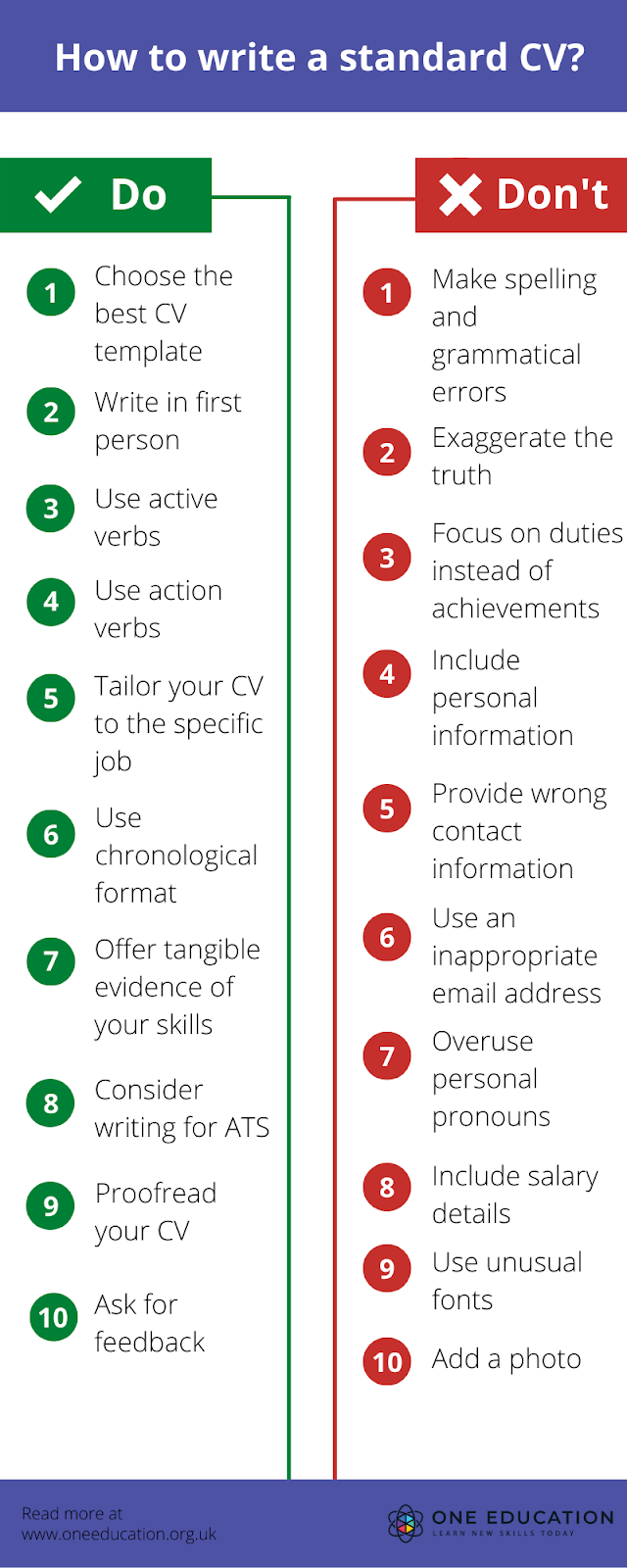When it comes to applying for a new job, your CV is the only key to secure an interview. But how do you ensure that your CV is added to the interview pile rather than thrown straight in the bin? From this blow you will find out how to deisgn the perfect CV that will represent yourself to your potential employers. You will also get loads of free CV templates and ideas from this blog.
Well, making up a standard CV is easy once you know how to. It’s a matter of taking all your skills and experience and tailoring them to the job you’re applying for. However, if you haven’t made any CV before, still you can put together a stellar CV that’ll make the recruiter read the whole document. Wondering how?
Read ahead and learn everything you need to know to create a successful CV and secure your first (or next) dream job.
What is a CV?
The CV full form is a Curriculum Vitae, which is a complete document that presents an entire history of your professional experience, educational background, and skills. The term Curriculum Vitae is Latin, meaning “course of life.” A CV is used when applying for jobs.
CV allows you to sum up your education, skills, and experiences, enabling you to show your abilities to potential employers successfully.
Types of CV
Before you get to the basics of a standard CV, you should know the types of CV you can use based on your preferences because it’s essential to choose the right CV format to present your skills, achievements and ambitions.
Generally, there are two main types of CV.
A chronological CV will list your experience and skills under appropriate headings, starting with the most recent ones. If you want to emphasise career progression and have no employment gaps, this CV format is best for you.
On the other hand, a Skills-focused CV will emphasise your skills and personal qualities rather than your employment history. If you have gaps in your employment history and want to show employers that your skills and experience can be relevant for the post, this format will show you exactly that. Moreover, if you have had a series of short term paid or voluntary roles, using this CV will help you group related skills and achievements gained from these.
Diploma in CV Writing
Why should you use Free CV templates?
CV writing is a skill that takes practice and a fair amount of trial and error. While applying for jobs, you might not always have the time to design and refine your documents. And it can be pretty tough to explain to a hiring manager or recruiter how much of a perfect candidate you are for that particular job role, especially with just two sheets of A4 paper. That’s where things like CV templates become helpful. Using a CV template will:
- Help save you time.
- Focus your efforts.
- Guide you to stay on task.
- Ensure that you don’t miss any critical information relevant to the jobs you’re applying for.
- And most importantly, secure an interview.
What to include in a CV?
No matter what job you want to apply for, you must know what you should include in the CV. But do you know what sections employers expect to see? Well, below is a list of information that you should put in each CV section. More importantly, it’ll give you an idea of what order to follow and which areas you should leave off.
According to the modern-day hiring standards, a standard CV has to include the following sections:
1. Contact information
This is the first section a recruiter will look at. You should include:
2. Personal statement (Personal profile)
This section highlights your key attributes and helps you stand out from the crowd. You should provide a concise summary of who you are and what you’re all about. It’ll not only express your career goals but also focus on the sectors you’re applying to. You can also include:
3. Work experience
This section is often closely scrutinised by employers and recruiters. You should list your work experience in reverse chronological order, meaning your most recent job should be at first and move backwards in time for every subsequent position. This way, the recruiter will see your work history and most recent achievements first.
Make sure that anything you mention here is relevant to the job you’re applying for. You shouldn’t include more than 15 years of relevant job experience. In each segment, include:
4. Education
List and date a summary of all previous education, including professional qualifications. Prioritise your most recent education first. However, if you have more than two years of relevant job experience, you should include all postsecondary degrees. Include:
5. Skills
This mandatory section gets a lot of attention as it shows whether you’re qualified for the position you’re applying for. So, list all the essential skills relevant to the job. However, you shouldn’t exaggerate your skills because you’ll need to back up your claims at the interview. So, you should include:
Standard CV format: Overview
Apart from the basic information, there are few additional sections that you can include in your CV. And such a standard CV might look something like this:
Additional CV sections
Download CV Template for Construction Engineer – [Doc]
Download CV Template for Construction Engineer – [PDF]
How to format a CV?
This is the part that causes many job seekers to struggle to land interviews with their current CV. No matter how good your CV content is, a poor format will always let you down. Therefore, you should always keep the following tips in mind while writing your CV.
Choose clear, readable fonts
Always choose a standard font for your CV writing. You can use:
- Arial
- Times New Roman
- Calibri
- Helvetica
- Cambria
- Georgia
- Verdana
- Trebuchet MS
- Avenir Next
- Book Antiqua
However, you should avoid fonts such as Comic Sans, Courier New, Lucida Console etc. You should use 11 to 12 pt font size and single spacing. Pick 14 to 16 pt font size for your name and section titles.
Keep the CV layout consistent
Ensure that all fonts and font sizes are consistent throughout the entire CV. Make sure the CV headings are uniform. You can make them larger and bold them out, too but go easy on italics and underlining.
Furthermore, you should stick to a single dates format on your CV. For example, use either 11-2017 or November 2017
Don’t fill your CV with unnecessary graphics
Do you know that after you send out your CV, it’s going to be printed in black ink on white paper most of the time? So, cramming your CV with gimmicky graphics might make it illegible. Remember, the white space on your CV will make the document look uncluttered and give the recruiters some breathing room.
Keep it concise
Don’t include every single detail about your life on the CV. The recruiters or the employers don’t have the time to read 10+ bullet point descriptions of past jobs. Include only the relevant information. If you keep it concise, it’ll allow the potential recruiters to skim your CV easily and pick out important information first.
How to write a standard CV?
It needs quite a bit of editing and formatting to make a CV standard. As shown in the standard CV template, it should include different sections, each containing certain information based on your field of expertise and job advert. However, you should follow some rules while writing the information on the CV.
Choose the best CV template
Create the right type of CV for your circumstances. For each job you want to apply for, you should choose the right CV template and write it based on the information on the job advert. You should also decide whether you need the chronological, skills-based or academic CV.
Write in the first person
When describing your background and qualifications, it’s better to use the first person rather than the third person. Because writing in the third person will only create distance between you and the person reading your CV. You’ve to write your CV in a way that it sounds like you’re talking directly to the recruiter or the employer.
Use active verbs
You should use active verbs on your CV to present yourself. For example, words like ‘created’, ‘analysed’, ‘devised’ show that you’re a person who takes initiatives. Furthermore, you should provide real-life examples that demonstrate your skills instead of using generic, overused phrases like ‘team player’, ‘hard-working’, ‘multitasker’ etc.
Use action verbs
Action verbs in your CV are more impactful than ordinary bullet points, starting with ‘adjectives’ to describe your experience. For instance, if you use a sentence like “Responsible for managing five customer support associates” followed by bullet points, it’ll be considered a bad bullet. Instead, you could say, “Led and trained five customer support associates, managing 200 incoming customer requests per day with a 98% customer satisfaction rate.
Tailor your CV to the specific job
This is the part that can take you one step further in getting hired. Because the employers want to see how your skills and experience match the specific role they’ve advertised. If you tailor your CV to the particular job, it’ll show that you’ve performed research into the company and the position you’re applying for. Therefore, you should:

Offer tangible evidence of your skills
Do you know that skills graphs are often ignored by ATS software? Those ranking graphs might look cool, but they don’t accurately represent your abilities. So, the best way to present tangible evidence of your skills is to do so in plain old text. For example, you can mention that you are Windows Certified instead of giving yourself a score of 9 out of 10 in Microsoft 365. Likewise, you can say how you led a team of 10 sales assistants in steadily increasing sales targets by 25%.
Consider writing for ATS
You should consider Applicant Tracking Systems (ATS) when writing your CV. Because if the ATS doesn’t understand your CV, a human recruiter won’t even set eyes on it. But how do you ensure that your CV is ATS-friendly? Here’s how:
Get your keywords right
Most of the recruiters use keywords to pick out candidates with the required skills and qualifications. And the ATS look for these keywords in candidate CVs. Check the job descriptions and find the relevant keywords.
Be consistent with the formatting
You have to make sure the formatting of your CV is consistent, well-organised and easy to read. The ATS algorithms will reject your CV if it includes:
Proofread your CV
Do you know that typos and grammatical errors can cause your CV to get binned? Especially if you’re applying for the editorial position, it’s imperative to proofread your CV before sending it. However, grammar and spelling issues aren’t the only thing you should proofread; you also need to double-check:
Ask for feedback
When it comes to self-editing your CV, it’s pretty normal that you can be a little biased. But it doesn’t mean you have to hire a professional editor to go over your CV before applying for jobs. You can ask your friends or family members to scrutinise it. Indeed, they might be able to give you valuable feedback or even spot an error that you couldn’t.
Remember, the employers and recruiters spend most of their day evaluating CVs. And their first review involves noticing anything that doesn’t fit the job requirements or something that raises a red flag. So, if you’ve made common CV mistakes, now is the time to fix them!
Diploma in CV Writing
Common CV mistakes you should avoid
Your CV needs to be perfect if you want to impress the recruiters and secure an interview. And for this to happen, you need to consider the following things to leave off your CV, so you don’t bomb your job search efforts.
Spelling errors and bad grammar
A standard CV shouldn’t have any spelling or grammar mistakes. Because writing a CV is all about making a good impression. But there are plenty of CVs getting rejected every day for spelling mistakes and poor grammar. So, you should get rid of these from your CV by:
Exaggerating the truth
You should be confident and sure about who you are, what you have to offer. Be honest about what you know and what you’re still eager to learn because skills can always be taught. Therefore, you shouldn’t lie or exaggerate on your CV. Remember that overselling yourself will only demonstrate your dishonesty, and there can be severe consequences. For example, altering degree grades and using fake documents within your CV is considered a criminal offence. It falls under the Fraud Act 2006. And if you’re convicted of this crime, you could face up to 10 years of imprisonment.
Poor formatting
Poor formatting is one of the first things employers notice when they look at your CV. It can reflect badly on you because the recruits will think you don’t pay close attention to details. Your CV can even get rejected by the ATS before it reaches the hiring recruiter’s desk.
Focusing on duties instead of achievements
Recruiters don’t emphasise your day-to-day activities in your past jobs. So, don’t bore them with details about your previous duties. Instead, highlight your achievements in your previous jobs. Focus on what you’ve gained from your previous employment and what you can bring to the new position.
Including personal information
Providing personal information on your CV, like your height, hair colour, date of birth, marital status, sexual orientation or religion, is considered unprofessional and not accepted in general. However, there are cases when it’s perfectly allowable to include some personal information in your CV. For example, if you’re applying for a modelling job, you can include details about your height and eye colour or the number of children you have if you’re applying for a job in childcare. But usually, it’s best to leave these things out for more conventional jobs.
Providing wrong contact information
This is a common mistake that can send your CV to the “no” pile, even if an employer is really interested in you. The tendency to focus on the main content rather than small details can cause this. If you’ve listed an old phone number or misspelt your email address, chances are you’ll miss out on a once-in-a-lifetime opportunity.
Using an inappropriate email address
If you’re still using the email address you hilariously set up in high school or college, don’t use it in your CV. A potential employer can reject your CV if it contains cryptic email addresses like some vanity licence plates. For example, catlover43@*****.com or IHearVoice@*****.com. Instead, create and use a professional email address, preferably containing your first and last name, like johnsmith@*****.com. Keep it simple!
Overuse of personal pronouns
While writing the CV in the first person, many candidates overuse personal pronouns like “I”, “me”, and “my”. As a result, the CV becomes wordy or lengthy. So, you should try writing your CV in a telegraphic style. Getting rid of unnecessary personal pronouns will give you that extra space to add in important information that you were forced to remove.
Additional tips
Free CV templates
We’ve come up with a range of different free CV templates to give you a hand with your application. It’ll not only take some hassle out of the application process but also help make your name stand out. You can use these templates as a basis for building your standard CV that’ll secure the job. Furthermore, it’ll give you an idea of what you should include and why.
Free CV templates for teachers
Teachers spend most of their working life preparing other people for the challenges of life. But when it comes to writing a teacher CV, you’ve got to prepare yourself. Because a teacher CV is all about you. You’ve to showcase your skills, experience and achievements.
Personal statement.
Briefly describe yourself, what you want to offer to the employer and what your career goals are.
Work experience
List your most recent job and then go back to listing any previous employment in order:
Education
This is the most important section for you because you’re an educator yourself. Follow these standard rules to present this section:
Skills
Besides subject expertise, you also need a lot of skills to communicate it.
Download CV Template for Teacher – [Doc]
Download CV Template for Teacher – [PDF]
Free CV templates for teaching assistant (TA)
Writing a teaching assistant CV can be challenging with all the heavy workload and so many responsibilities on your shoulders, as the pressure on the education system is constantly increasing. A teaching assistant has to show in the CV that they can work with students in one-on-one, small groups and whole classroom settings. They may also need to demonstrate their ability to give individual support to children with special education needs.
Therefore, you should focus on your features, experience and education. Look at the following highlighted sections, for example:
Personal statement.
Briefly describe your personality and enthusiasm for the role in a way that persuades the recruiters to keep reading. You can consider these questions while writing your personal statement:
Work experience
This is the crucial section of a teaching assistant CV, and you have to prove that you’ve got the expertise to do the job:
Education
You should present this vital section of the CV following a standard set of rules:
Download CV Template for Teaching Assistant- [Doc]
Download CV Template for Teaching Assistant- [PDF]
Free CV templates for managers
Leading, coaching and mentoring, are three key roles among many other responsibilities of a manager. So, your CV for a managerial position must do so much more than just a list of experiences and education. You need to show a range of job-specific skills in your CV.
Manager CV objective or CV summary
If you’ve just launched your leadership career, you should write a CV objective. And if you have the experience being a manager in other companies, you should write a CV summary:
If you’re about to write an entry-level manager CV, include a few actual achievements from past non-management jobs.
If you have few years of experience in this sector, briefly describe your previous duties with achievements.
Use bullet points to list your responsibilities.
Work experience
This section can secure the job if you can show it better on your managerial CV:
If you think you’re not experienced enough, think of the following questions as a backup:
These are all management duties. So be sure to add these to your CV.
Education
Though experience matters more than education in a managerial CV, you should still list your education. Write your degrees in full form. Include the names of your college and university with the location and the dates you attended.
Skills
Of course, you need to mention the soft and hard skills on your CV. You should include:
Download CV Template for Manager – [Doc]
Download CV Template for Manager – [PDF]
Free CV templates for programmers
Programming is a job that can be done from anywhere in the world. And the major companies outsource programming jobs to countries where wages are lower. That’s why programmers and software developers are in high demand nowadays. However, those companies still need on-site programmers. Hence, you need the best programmer CV to get a job in this competitive sector.
Programmer CV objective or CV summary.
If you’re a junior programmer, self-taught or entry-level programmer, you should use a CV objective. Conversely, if you’re a senior programmer and looking for a job in managerial or executive positions or specialised positions such as C++ programmer or Python programmer, you should choose a CV summary:
- Write this section focusing on the employer’s benefit rather than from the perspective of your personal gain.
- Use bullet points to list your programming skills and duties with hard numbers.
Work experience
This section has to be jaw-dropping if you want your dream programmer job.
Projects
You should add a good list of programming projects to your CV. It’s one of the first things the recruiter expects to see:
Education
Commonly, you’re required to have a bachelor’s degree. However, education isn’t the primary focus of the recruiters. Just include your highest degree of education, mentioning your major, your college’s name and location, and graduation dates.
Programmer CV: Skills section
It’s a bit tricky to list your programming skills on your CV. For example, if you know 10+ programming languages and feel tempted to show it off, you can’t just add them all to your programming CV. Because being familiar with many programming languages and being an expert on each of them are different. You should only add these to the skills section only if they’re relevant to the job description:
Download CV Template for Programmer – [Doc]
Download CV Template for Programmer – [PDF]
Free CV templates for engineers
Engineers act as the interface between research and reality. Their work involves a wide range of areas, so their CV may vary depending on the role.
Engineers work in various fields, and as a result, their resume can vary significantly based on the position.
Personal statement
Depending on your experience level, you should describe your attributes and why you think you’re fit for the job.
Work experience.
This section should be your foremost priority:
- Write down your work experience in reverse date order.
- For each role, include the job title, name of the employer, dates of employment.
- Include up to 4-6 bullet points to describe the job. Use action verbs to make the bulleted points stand out.
- Write about quantifiable and numbered achievements along with the summaries of your duties.
Education
Your formal education in mathematics and scientific disciplines forms the basis for your professional achievements
List all your degrees in the full formal name along with the dates you studied there and the name of the university you attended.
For more than one qualification, follow reverse chronological order. Only include honours if you have attained a first or a 2:1.
Skills
There are dozens of specialised fields in engineering. Each one requires its own sets of skills.
If you’re a fresh graduate, switch your CV sections’ order and put your education before work experience.
Engineer CV Skills Sample
Download CV Template for Engineer – [Doc]
Download CV Template for Engineer – [Doc]
Free CV templates for nurses
Nursing is one of the fastest evolving professions globally, and registered nurses are in high demand. As a result, it may be easy for nurses to find job opportunities. However, you should optimise your CV before applying for a job in this sector.
Remember, clarity is vital, so ensure that the most important and impressive details are easy to pick out from your CV. Here are some of the essentials you’ll want to include:
Nursing CV summary or objective
If you are a fresh graduate or a nurse with insufficient experience, you should choose an objective for a nursing CV. On the other hand, if you have experience in this sector, then use a CV summary.
Work experience
Nursing CVs aren’t achievement-driven like in other professions. But you must include basic responsibilities in the CV to avoid getting rejected. You should include the followings in this section:
Credentials
Include your license, certifications and awards in this section.
Download CV Template for Nurse – [Doc]
Download CV Template for Nurse – [PDF]
Free CV templates for child care providers
If you’re about to write a child care CV, keep in mind that you’re applying to one of the most challenging jobs on the planet. And getting this job is just as hard. Because parents want the best for their kids and the childcare centres want the best candidates.
Child care CV objective or CV summary
If you’ve child care experience, you should use the CV summary. And if you don’t have any child care experience, but you love spending time with children and looking for a career full of fun and experiences, then you should write a CV objective statement.
Work experience
If you know how to calm a colicky baby, that’ll count as an experience too. But if you have a work history, it’ll intrigue the recruiters.
Education
If you have relevant education, list your degree in full form, with the name of the university you attended, location and the dates of graduation. But if you’re still finishing up your degree, include the expected graduation date. And if you only have a high school diploma, add it too.
Skills
Whether you want to write a CV for child social services or be a first-time nanny, you have to show your skills to the employer. Jot down all your soft and hard skills and include only the relevant ones in your CV (based on the job description).
Download CV Template for Child Care Provider – [Doc]
Download CV Template for Child Care Provider – [PDF]
Free CV templates for social workers
Social workers help people. But not all social workers jobs created equal. So, if you want an excellent job in this sector with solid pay and benefits, you need to make a CV that’ll stand out. All you need to do is show your skills and achievements the right way.
Social worker CV objective or CV resume
Choose a CV objective if your experience in this sector is still taking baby steps. Conversely, if you have had good enough experience, you can show it here. However, you have to load either one with measurable achievements.
Work experience
Start with your most recent job. Use bullet points to focus on your achievements. If you’re an entry-level social worker and thinking that you’ve no experience, then consider the following questions:
If you have “Yes” as answers to the above questions, then adding these to your CV will definitely make it a distinctive one.
Education
Start with your school name and location, dates you attended and the full form of the degrees you have. You can also add achievements here that fit the job.
Skills
Read the job description closely. Use bullet points to list the relevant skills. But do you know the common social work skills that are required everywhere in this sector? They are:
Download CV Template for Social Worker – [Doc]
Download CV Template for Social Worker- [PDF]
Free CV templates for firefighter
It’s a job where one mistake can kill. And the recruiters don’t just toss the jobs to anyone. You’ve to prove your worth on a single sheet of paper. But the good news is it’s not a five-alarm assignment.
Firefighter CV objective or CV summary
Choose CV objective if your firefighter experience is sputtering. And if you have passion and want to contribute your extensive knowledge, skills and experience in this career, choose CV summary. Briefly explain yourself and your passion in this sector. Use bullet points to highlight your previous experiences with suitable examples.
Education
It’s not mandatory to have the education to become a firefighter. A highs school diploma is enough. However, you have to show whatever education background you have. Start with school name, location, years in school and the degrees you have. Add relevant firefighter accomplishments as well
Skills
Well, you can’t say “I’m skilled” on a firefighter CV. So, pick the right skills from the job advert. Then use bullet points to prove them just enough to get the interview. If you have skills like vehicle maintenance, dependability or training skills, you’ll definitely impress the recruiters.
Certification
If you have certification in any firefighting course, don’t make the rookie mistake of burying them. Certification matters to a great extent in this sector, as long as you show it right on your CV for firefighter jobs.
Download CV Template for Firefighter – [Doc]
Download CV Template for Firefighter – [Doc]
Free CV templates for fashion designers
Your fashion designer CV should spark enough interest for the recruiters to want to inspect it further after a quick glance at it.
Fashion designer CV objective or CV summary
Sum up the main points of your fashion designer CV in the opening paragraph. If you have over two years of professional experience under your belt, choose CV summary. And if you’re looking for an entry-level position in this sector, choose CV objective:
Work experience
Education
The Majority of the job openings in fashion design require you to have a certain level of education:
Skills
Your fashion designer CV should focus on relevant skills:
Download CV Template for Fashion Designer – [Doc]
Download CV Template for Fashion Designer – [PDF]
CV vs. Resume: Key differences
The key difference between a CV and a resume lies in the length, layout and purpose of these documents. For example:
The difference between these two documents may vary internationally. For instance:
Diploma in CV Writing
Conclusion
If your CV is a standard one, it’ll definitely make the recruiter say, “He’s got the skills we need. Let’s hire him”, because your CV is your only chance to make a great first impression and secure yourself an interview. And at this point, you should be confident enough to get your CV right from the outset.
FAQs
1. Can I download a CV for free?
Yes, you can download a CV for free from One Education’s website.
2. Is there a truly free CV template?
Yes, there are genuinely free CV templates available on One Education’s website. You can download and use them without any cost.
3. How to write a personal statement for a cv?
A personal statement for a CV should clearly outline your career goals, relevant skills, and key experiences. Start by briefly introducing yourself and highlighting your career objectives. Mention your most significant achievements and skills that align with the job you’re applying for. Keep it concise and focused on how you can add value to the employer.








 March 14, 2024
March 14, 2024














